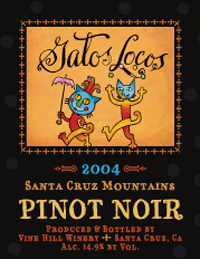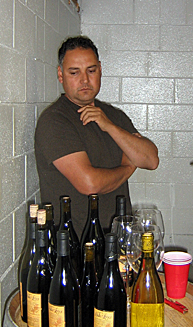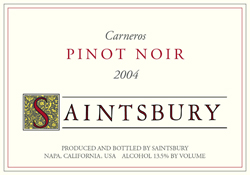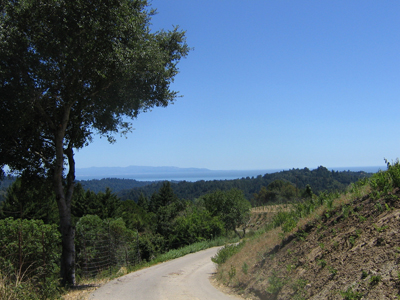

Vine Hill Winery is producing a diverse family of wines with different brands, all under the direction of Sal Godinez.
The Six Bucks-an-Hour Gardener
Who Became a Top Dollar Pinot Wiz
Sal Godinez's success story as a winemaker is a textbook American tale of an immigrant working hard, talent winning out, and, oh yes, having a intuitive knack for making Pinot Noir.
by
Laura Ness
October 17, 2007
 al Godinez is one of those great success stories which highlight how critically important a sensible immigration policy is to the viability of this country’s agricultural industry. Born in the small mountain town of Zamora outside of Michoacan, Mexico, Sal first came to California in 1980 as a teenager, to help his brother pick crops. He ended up in Lompoc, then a vast sea of flower fields interspersed with row crops that blanketed the fog-kissed hillsides all the way to the coast.
al Godinez is one of those great success stories which highlight how critically important a sensible immigration policy is to the viability of this country’s agricultural industry. Born in the small mountain town of Zamora outside of Michoacan, Mexico, Sal first came to California in 1980 as a teenager, to help his brother pick crops. He ended up in Lompoc, then a vast sea of flower fields interspersed with row crops that blanketed the fog-kissed hillsides all the way to the coast.
“We did contract work by the piece, picking lettuce, broccoli, and many kinds of crops. With all the nursery fields, it was breathtakingly beautiful,” recalls Sal. “I remember the walnut orchards and going to the ocean to fish. It was very appealing.” He returned to Mexico to finish high school, returning in 1985 to California at the behest of his sister, who was then married and living in Rutherford. Her husband worked in the vineyard at Freemark Abbey, and that connection led to Sal’s first job at the winery.
“I was a gardener. I got paid $6 an hour, which wasn’t much, but it paid off. Fifteen months later, a cellar opening became available and I asked for the opportunity to be

C’mon Sal, don’t be shy: You are the Pinot “Crazy Cat.”
Although he aspired to be the assistant winemaker at Freemark Abbey, the owners had other plans, and Sal left in 1996, on good terms, but ready for a new challenge. In June of that year, he was contacted by Byron Kosuge, the winemaker at Saintsbury, who had discovered his resumé left on a desk by a friend who was helping Sal put it together.
The Experiments Begin
“I’d never made Pinot Noir, and I really didn’t have any appreciation for it. I was strictly a Cab guy, being at Freemark Abbey. So, it was a big learning opportunity for me,” confesses Sal. “Saintsbury was so committed to Pinot (that) it was an ideal learning environment. They were very much on the leading edge of Pinot clonal experimentation. They were the first winery in California to make a Pinot totally from Dijon clones.”In producing fine Pinot Noir, much of the emphasis is on the integration of different clones in the bottle. Coincident with his new job, Sal embarked on another educational journey, this time studying viticulture at
 Napa Valley Junior College. During his studies, he was able to rely on his natural skills as a gardener and enhance his knowledge of the importance of vineyard management.
Napa Valley Junior College. During his studies, he was able to rely on his natural skills as a gardener and enhance his knowledge of the importance of vineyard management.
He was also able to apply his new education and build on industry knowledge regarding the best use of Pinot clones and grape rootstocks. “I realized that the more I knew about vineyard practices, the better winemaker I would be. The importance of vineyard work cannot be overstated. Much of the final product of a wine is made in the vineyard. You can make excellent or poor wine from great grapes but you cannot make great wine from bad grapes. The less we have to do in the cellar, the better.”
Studying viticulture was both enlightening and a necessity for someone working in what was rapidly becoming a house of Pinot. “With Cabernet, you have 6 clones, max. With Pinot, you have 50 clones and the rootstocks play an enormous role. The possible combinations are vast. I developed what I call ‘the pyramid of consistency,’ to help make consistently good wine. You pick three clones, say 115, 667, and 777 and you put them each on two or three different rootstocks. You ferment each clone-rootstock combination separately and you complete two different fermentations. That gives you 12 to 18 unique combinations to play with. It’s a very small way to ‘enhance nature,’ although we all know nature does the heavy lifting.”
What’s the most interesting part of this experiment? “Barrels!” Sal says, with a grin that exudes enthusiasm. “Barrels are the best part. People often buy barrels based on what other people – salesmen usually – tell them. I choose them based on the results of fermentation. I prefer Francois Freres (of Burgundy) and Taransaud (of Cognac).” When asked how the barrels are integrated into the wine, Sal responds, “The 115 clone is very tannic and requires good, soft oak with little wood tannin.” Sal prefers to use 60 to 70 percent new Taransaud. For 667, which has good body and little tannin, he goes for Francois Freres barrels, which add oak tannins.
The Smell of the Wood, The Aromas of the Wine
Sal loves 777 for its aromatics: “I never use heavy toast on 777 because I don’t want to overpower it.” He tends to use less new oak here. What about Pommard? “It’s an excellent blender. Oak is less important. It has nice body, big tannins, and has great aromatics in cooler years. The fermentations with Pommard, especially with the Raffaelli Vineyard (in the Santa Cruz Mountains) need to be watched carefully. Malolactic fermentations tend to kill the color, so temperature control is critical.”Back to the career path: How did Sal come to be the winemaker at Vine Hill Winery in the Santa Cruz Mountains? Well, again, he tried for a rim shot and the ball ended up in a different court. Instead of getting the winemaker’s job at Saintsbury, Sal was approached by Nick

The view from Vine Hill Winery spans across the Santa Cruz Mountains to Monterey Bay.
The place has been continuously planted to several varieties of grapes since the early 1860s. In the early 1900s, the vineyard was planted to Zinfandel. Although David Bruce made some spectacular Zin from this property in 1968, the climate doesn’t have the lizard-friendly conditions that routinely produce great Zin. After buying the property in 1968, Bruce made one vintage from the Zinfandel grapes already in existence and then replanted to Pinot Noir. The site, with its perfect Region I fog-influenced climate, is ideal for Pinot Noir.
Sal now has responsibility for Gatos Locos of Vine Hill, a broader California brand










 READER FEEDBACK: To post your comments on this story,
READER FEEDBACK: To post your comments on this story,




